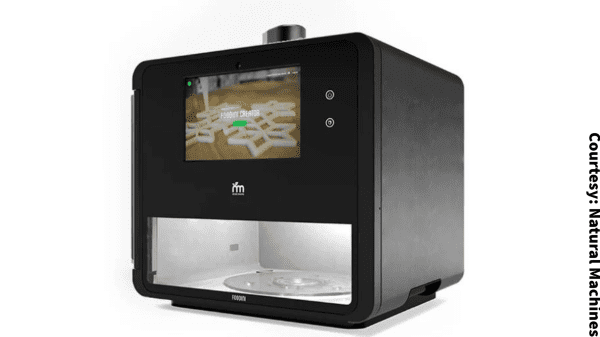The fresh produce industry has three principal direct competitors: frozen food, shelf-stable (i.e., canned) food, and processed food.
The third category is experiencing innovations that will increase its appeal. Some of these have to do with three-dimensional (3D) printing, a technology that is revolutionizing many fields. It’s also sometimes called additive manufacturing.

The process starts with a 3D digital image of the object you want to construct. Using this as a template, a 3D printer uses a nozzle to spit out, layer by layer, an actual duplicate in whatever substance you’re using. Think of it as an inkjet printer working in 3 dimensions.
What can this technology build? How about a helicopter? In 2017, GE engineers produced a 3D-printed helicopter consisting of merely 16 different components instead of 900.
The use of 3D for processed foods—food fabrication—is rapidly developing. A Review on 3D Printing for Customized Food Fabrication – ScienceDirect
One possible ingredient: mashed potatoes. A new study in the Journal of Food Engineering goes into the details of this arcane but fascinating possibility. Printability, texture, and sensory trade-offs for 3D printed potato with added proteins and lipids – ScienceDirect
You can use this technology to print mashed potatoes into all sorts of appealing shapes, according to a new study out of Texas Tech University.
“However, it is challenging to reliably print foods to form specified 3D designs with appealing and healthy ingredients. Here, 3D printed foods for improving appeal and/or nutrition were created by adding protein (pea/cricket) and lipid (butter) powder additives to mashed potatoes.”
Cricket? Yes, folks, we are going to be eating insects very soon—and in substantial quantities rather than in trace amounts. (You can’t totally eliminate insect parts from processed foods, so there is a tiny maximum that is permitted.)
In this case, the crickets come in powdered form. “All food samples had a high degree of dimensional accuracy, although higher concentrations of cricket mixture resulted in collapsed structures,” we learn.
We see a polarity in the American food industry. On the one hand, there is greater concern about additives in foods, as shown in consumer support for more detailed front-of-package labeling for added sugar, salt, and saturated fat.
On the other hand, we are seeing constant progress and sophistication in the processed food sector, as suggested above.
We generally assume that fruits and vegetables in their natural states are automatically more healthy than processed versions, but new technologies may cast this into doubt.
“Personalized nutrition can be achieved through 3D food printing, making it beneficial for athletes, individuals managing disease, and those seeking weight loss,” the Texas Tech study points out.
And of course, the technology offers great potential for consumer appeal. Not too far in the future, American moms may be able to choose between a five-pound sack of potatoes and an impressive and tasty sculpture of Bugs Bunny in their mashed equivalent.



